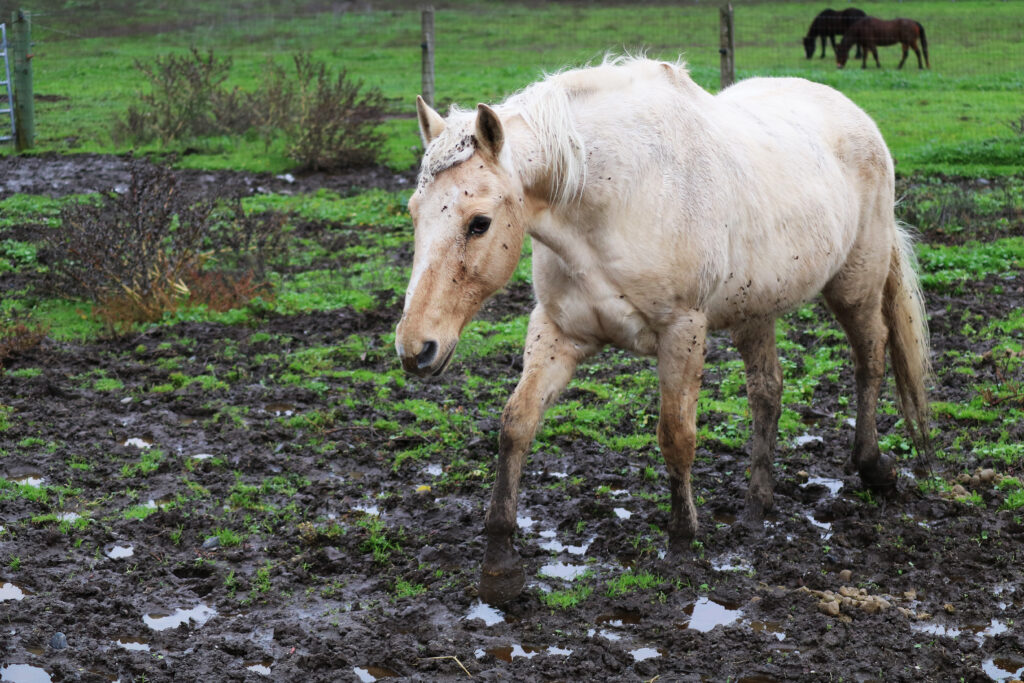Proper post-ride care is essential for keeping horses healthy, yet many owners may not realize the risks associated with prolonged exposure to moisture. Neglecting to dry and care for a horse after exercise can lead to a range of skin issues, some of which can cause significant discomfort.
A horse’s skin is a delicate balance of tissue, natural oils, and hair, constantly interacting with bacteria. While most of these microbes are harmless, certain conditions can disrupt this balance and lead to serious problems. One such condition is mud fever, a troublesome ailment that affects the legs and can result in irritation, scabbing, and infection.
What Is Mud Fever in Horses?
Severn Edge Vets notifies readers that the technical name for Mud Fever is pastern dermatitis, a skin infection that affects a horse’s legs. Despite the name, Mud Fever does not include fever as a common symptom. Instead, the name refers to hot, inflamed scabs which develop on the skin as the result of this bacteria driven condition.
As the name might imply, Mud Fever is often attributed to mud and how exposure to mud can be dangerous for a horse’s legs. This is a misinformed opinion and can actually cause horse owners to take actions that encourage mud fever rather than deter it. Mud is not the enemy that some horse owners believe it to be; in fact, mud alone doesn’t cause mud fever. Rather, it is a combination of the mud sealing in moisture and then the abrasive particulate in the mud cutting through the skin after it is softened and worn down.
Mud Fever can come as the result of many different causes, but constant exposure to moisture is the leading cause of this skin condition. Moisture and equine skin do not mix well, and equine skin is particularly sensitive when exposed to moisture for long periods. As you will learn in this article, it is of the utmost importance that you take care to keep your horse’s skin dry and conditioned.
Common Causes
The real danger for a horse developing mud fever comes from constant exposure to moisture, rather than occasional exposure to mud. Mud has been associated as a leading culprit for pastern dermatitis because many horses who become muddy seem to have a higher propensity for developing mud fever. In reality, it is not just the mud that causes the issue, it is also the act of over washing the legs.
If a horse’s legs are washed off with equine shampoo and then left wet, or at the very least dried improperly, that horse has a more than likely chance of developing mud fever. As the water sits on the skin, the skin tissue becomes soft and irritated; sort of like how human fingers become pruny in a bath. Horse and Hound asserts that if equine skin dries gradually instead of being dried properly, the skin is more likely to chip and crack. This is especially true if the skin has been wet for a long period. As the skin cracks, cuts and lesions form, allowing bacteria to penetrate the outermost layer of skin. Exposure of the inner layers of dermis allows for infections to take hold and grow, inevitably leading to skin problems like mud fever.

Mud fever is most commonly linked with a specific type of bacteria called dermatophilus congolensis. This bacteria is commonly found in loose sand, soil, and mud. This is why mud has commonly been believed to be the main culprit for mud fever. While there are other causes aside from dermatophilus congolensis, this particular bacteria threatens to compromise the integrity of equine skin health.
World Horse Welfare suggests that mites are also a leading contributor to a horse contracting mud fever. As mites burrow into the skin, they cause small openings where bacteria can enter the underlying tissues. Once bacteria enter the deeper layers of the dermis, it can multiply and spread, causing a host of skin infections, one of them being mud fever.
Additionally, mites tend to cause horses a great deal of discomfort. Horses afflicted with mites tend to stamp their hooves and scratch at their legs to alleviate the itchiness caused by mite infestations. Scratching the skin is a leading cause of forming open wounds, which can lead to mud fever.
Mites are often found in damp bedding, so the living quarters of your horse must be kept clean and dry. If your horse has mites, mud fever is likely not far behind, and both issues will need to be addressed before health is restored to your horse.
Signs and Symptoms
Most commonly, mud fever affects the feet and legs, so it is of the utmost importance to pay attention to the lower half of your horse. Mud Fever predominantly affects the feet and legs in the form of red, puffy scabs. These scabs will often look like they are matted and can even be prone to oozing fluid, Here are the most common signs and symptoms of mud fever:
– Red, puffy scabs on the legs and feet
– Swelling of muscle tissue
– Open and oozing sores or lesions
– Patchy scabs up the hindquarters
In advanced stages of the infection, the scabs and lesions commonly associated with mud fever spread up the hindquarters of the legs. In its advanced stages, mud fever is apt to become cellulitis or staph infection. If this occurs, then drastic measures will need to be taken, and a Vet will need to administer heavy doses of medication. While it is unusual for mud fever to become this advanced, it is possible, especially if a horse is left unattended or uncared for.
Eliminating the infection
Mud fever in horses is treated with a combination of sterilization and immunization, which in combination can eradicate the condition entirely. The most common mud fever in horses treatment includes gently removing the scabs that form from the infection.
The infection lives under the horse’s skin and is protected by the hard-crusted surface of the scab itself. The only way to expose the infection and treat it is by removing the scab for a thorough cleaning. Once the scab is removed, the wound needs to be cleaned, sterilized and kept as dry as possible. In some instances implementing the use of bandages can be an effective method of keeping the wound dry. However, the bacteria which causes mud fever cannot survive in an oxygen-rich environment, which is why leaving the wound uncovered is acceptable.

The two most effective methods of removing the crusty scabs are to softly brush the skin until the scab comes loose or to soak the affected area in an antimicrobial solution. Brushing away the scabs is the preferred method as it prevents the introduction of any additional moisture.
For maximum results, lightly rub a hydrogel onto the scab and surrounding area before you attempt to peel or brush the scab away. The hydrogel will help dislodge the scab and protect the horse’s skin in the affected area. Even if the crusty scabs are loose, peeling, or brushing them away can be painful for your horse, so be careful.
You will need to apply an antimicrobial agent to the open wound and be careful to keep it clean and cared for until the infection goes away. Many vets will prescribe oral antibiotics to be taken in conjunction with topical treatment. Mud fever treatment that’s topical should be limited to every 2-3 days to allow the wounds to heal and dry properly.
Prevention
As is the case with most equine ailments, it is far easier to prevent infection than it is to treat it. In the case of Mud Fever, keeping your horse’s skin healthy and dry is one of the key components for preventing skin infections like Mud Fever.
Horse Journals recommends that keeping your horse in a clean, dry environment is the first step in preventing mud fever. If your horse is constantly exposed to wet, muddy conditions, you must take the time to clean and dry your horse’s legs properly.
Keeping your horse out of the rain and mud will do wonders for preventing mud fever. However, should moisture become a persistent threat, you should make use of an antimicrobial solution as a method of keeping bacteria at bay.
The Importance Of Healthy Skin
Your horse’s skin is his first line of defense against illness. The health of the skin, in large part, determines the overall health of your horse. The more your horse’s skin is allowed to deteriorate or become compromised, the greater the risk of bacterial infection and other illnesses.
Antimicrobial solutions are an excellent way to promote healthy skin in your horse. While it is unnecessary to spray your horse all over with an antimicrobial agent, you should attempt to identify any areas on the skin where there are scrapes, cuts, or any other minor abrasions.
Applying a topical wound and skin antimicrobial treatment to areas of mild concern will help to prevent the development of greater issues. Preventative action, like the use of an antimicrobial agent, is an excellent means of ensuring your horse’s skin remains healthy, even if it has potentially been compromised by a minor wound.
If you are ever in doubt about your horse’s overall health, you should call a Vet for an expert opinion. Skin conditions, especially when left untreated, can pose a great health risk to your horse, so vigilance is key in preventing issues like mud fever. Mud fever is a challenge that many horse owners face, but when treated with diligence and patience, it can be easily overcome.
Sources:
- https://www.severnedgevets.co.uk/equine/advice/under-skin-truth-about-mud-fever
- https://www.horseandhound.co.uk/horse-care/vet-advice/mud-fever-72429
- https://www.worldhorsewelfare.org/advice/health/mud-fever-and-horses
- https://www.horsejournals.com/horse-care/illness-injury/diseases/how-rid-your-horse-mud-fever
 Dr. Melinda J. Mayfield-Davis, DVM, WCHP-AH, brings over 20 years of experience in veterinary medicine. She is the Technical Services Veterinarian with Innovacyn, Inc., parent company of Vetericyn Animal Wellness. She received her DVM from Oklahoma State University and now resides in Southeast Kansas with her husband, two children, four dogs, and six horses. Prior to working with Innovacyn, Dr. Mayfield owned and operated the Animal Care Center in Columbus, KS.
Dr. Melinda J. Mayfield-Davis, DVM, WCHP-AH, brings over 20 years of experience in veterinary medicine. She is the Technical Services Veterinarian with Innovacyn, Inc., parent company of Vetericyn Animal Wellness. She received her DVM from Oklahoma State University and now resides in Southeast Kansas with her husband, two children, four dogs, and six horses. Prior to working with Innovacyn, Dr. Mayfield owned and operated the Animal Care Center in Columbus, KS.